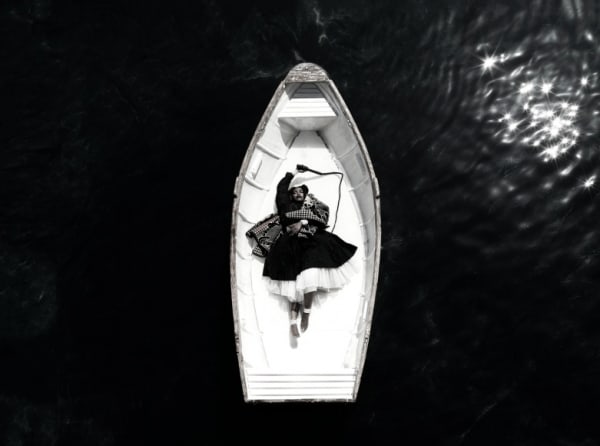Jenkins Johnson Gallery is pleased to announce its participation in Expo Chicago at Navy Pier, September 13–17, 2017 in booth 645. Jenkins Johnson will feature works that create a dialogue on marginalization, colonialism, politics, and the environment. The international presentation will include Lavar Munroe (Bahamas), Blessing Ngobeni (South Africa), Deborah Roberts (United States), Mohau Modisakeng (South Africa), Nnenna Okore (Nigeria/United States), Aida Muluneh (Ethiopia), Hendrik Kerstens (Netherlands), and Gordon Parks (United States).
A new large-scale installation by Lavar Munroe (b. 1982, Nassau, Bahamas) will be unveiled in the IN/SITU sector- the fair’s annual showcase for monumental artworks organized by Florence Derieux, former curator of American art at the Centre Pompidou. Titled, And the Dogs Went Silent, Munroe’s installation consists of a parachuting rider encircled by snarling beasts. These dogs reference a long history of trauma related to African Americans, from the use of hunting dogs to track escaped slaves, to the police dogs set loose on civil rights protestors.
Munroe, a participant in Okwui Enwezor’s 56th Venice Biennale, and in Trevor Schoomaker’s upcoming Prospect 4, will present sculptures from his new series Gun Dogs. They are “attack dogs,” trained to defend or attack a territory, property or persons on sight or on command. This phrase gives a link between contemporary and historical violence against the Black body, particularly in the use of dogs to hunt runaway slaves and to aid law enforcement in intimidating both civil rights protestors and those of today. He asks us at what point does enforcement become a hunting exercise, and to what extent are animals, and their owners, trained to associate a specific demographic as perpetrators? The sculptures are built mainly from salvaged cardboard. Munroe is presented alongside Gordon Parks, whose works from the civil rights period document the precise moment in American history that police dogs were used to violently attack protesters, as well as echo today’s continuing unrest.
Munroe will participate on two panel discussions at the fair: Race and Representation in Contemporary Institutions (Thursday, September 14, 5-6pm), with Michelle Joan Wilkinson (Curator, National Museum of African American History & Culture) and Bomi Odufunade (Dash & Rallo Art Advisory), moderated by Perri Irmer (Preseident and CEO, The DuSable Museum of African American History); and IN/SITU Chronopolitics (Saturday, September 16, 12-1pm) with Bethany Collins (Artist, PATRON, Chicago) and Dan Peterman (Artist, Rhona Hoffman Gallery, Chicago), moderated by Florence Derieux (2017 IN/SITU Curator).
Blessing Ngobeni (b. 1985, Tzaneen, South Africa) was recently described in Phaidon’s Vitamin P3 and Artspace as one of the “most important African painters working today” alongside Njideka Akunyili Crosby and Meleko Mokgosi. Like Munroe, Ngobeni incorporates a range of discarded materials from newspaper clippings to magazine cutouts in his work. His large-scale, mixed media paintings serve as a scathing condemnation of South Africa’s political and social elite. His work brings attention to the failures of the government to deliver on Nelson Mandela’s promises of a more equal society after Apartheid, and the angst of living in a world that seeks to silence the voice and pain of black people. He borrows from the language of Surrealism, the anarchy of Dada and the figurative violence of Neo-Expressionism. His works are in public institutions throughout South Africa including Johannesburg Art Gallery.
Mohau Modisakeng (b. 1986, South Africa), representing South Africa at the 57th & 56th Venice Biennales, creates video installations and photographs that sit at the intersection of identity and body through the lens of global capitalism. His practice grapples with black male identity, body and place within a post-apartheid context. His work, Passage (2017), meditates on slavery’s dismemberment of African identity and its enduring erasure of personal histories. The movement of the water symbolizes the many who have arrived to or departed from South Africa in trade, as cargo or as transient bodies, belonging to no particular state. Modisakeng’s photography, performance, and installation work are informed by South Africa’s recent violent political transition.
Deborah Roberts (b. 1963, United States) engages issues of race, beauty and Black women’s bodies through collage. With image fragments from historical and contemporary periodicals, Roberts creates compositions of Black girls that subvert stereotypes. The girls she portrays break the media’s beauty standards that center whiteness and youth. By combining interspersed images of iconography, such as Afros, large hoop earrings, nappy hair, and big red lips, Roberts comments on the hyper-sexualization of Black pre-adolescent girls. Her goal is “to show women of color that their bodies should be cherished and honored.” Roberts is a Pollock-Krasner grantee. Recent exhibitions include the George Washington Carver Museum, TX, the National Museum of Mexican Art, IL and the Drawing Center, NY. She is currently featured at the Studio Museum in Harlem and has an upcoming solo exhibition at Mass MoCA.
Nnenna Okore (b. 1975, Australia, raised Nigeria, lives Chicago, IL), a former intern of El Anatsui and recent Fulbright Fellow, creates organic and twisted structures that mimic the intricacies of the fabric, trees, bark, and topography familiar from her childhood in Nigeria. In her newest works, the Okore aspires, “to represent through the use of visual metaphor, and vibrant elements the potency and ephemerality of life and its natural cycles.” Nnenna Okore states, “I am interested in understanding the role that people, materials and geography play in shaping and redefining our ecological landscape.” While her works have evolved in the last decade, they continue to reveal the uniquely diverse and tactile characteristics of our shared physical world. “My goal as an artist is to find inspiration around me and inspire others.” Nnenna Okore is a Professor of Art at Chicago’s North Park University, where she chairs the Art department and teaches Sculptural Practices.











